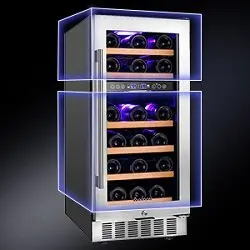Wine is a remunerating leisure activity that has some delightful advantages. Regardless of whether you’re simply getting into the wine world or you’re hoping to develop your present wine assortment, there’s something else to find out with regards to it.
One of the most challenged points in the wine world is the temperature at which you should store wine. Many individuals have their own viewpoints, so it tends to be difficult to figure out the commotion to track down the right reply.

For what reason Does Wine Need to Be Chilled?
Wine is an intricate beverage. The aging and maturing process is fragile, particularly in more costly wines. Wines keep on maturing while they’re in the container, so appropriately putting away your wine is critical to keeping up with its quality.
Temperature is a significant piece of wine stockpiling. Hotness makes wine age all the more rapidly, while lower temperatures cause it to age all the more leisurely. Contingent upon the wine, you might need to chill it a little, or a considerable amount. It relies upon the wine.
Also Read: Best Commercial Beer Fridges
However, regardless, you want to keep your wine in a cool and dull spot. An excessive amount of light and hotness can really make your wine separate. The liquor and sugar ages considerably further and transform an entirely decent wine into vinegar, destroying your speculation. This is the reason to store your wine appropriately.
The Best Temperature for Every Type of Wine
Things being what they are, you realize you want to keep your wine cool, yet at the same how cool? Each wine is unique. Subject matter authorities agree white, red, rosé, and shimmering wine are completely served best at various temperatures. Here is the breakdown of what wines are best at which temperatures.
Red Wine
Out of all wines, red wine handles warm temperatures the best. Red wines are complicated and have moderately low acridity. To get the full impact of full-bodied red wines like a Bordeaux, chill them to somewhere in the range of 60 and 65 degrees Fahrenheit. For a similar explanation, invigorated wines like Port are best on the hotter finish of the temperature range, more like 65 degrees.
The lighter-bodied the wine, the cooler you can keep it, so a few Cabernets are best somewhere in the range of 55 and 60 degrees Fahrenheit.
White Wine
White wines are more fragile than reds, with a more elevated level of acridity that advantages from cooler temperatures. As a general rule, whites ought to be kept on the cooler finish of the range, somewhere in the range of 45 and 55 degrees Fahrenheit.
There are varieties here, also. Chardonnays will generally have more body than different whites, so they are best capable around 55 degrees. Then again, light, fruity whites can be kept cooler, around 45 to 50 degrees, to hoist their lighter flavors.
Rosé Wine
Rosés will more often than not be lighter, fruity wines. That passes on them at their best around 50 to 55 degrees Fahrenheit. Pastry wines and rosés advantage from the chill to carry their pleasantness to the cutting edge without overpowering the sense of taste.
Shining Wine
Of all wines, shining wine ought to be kept coldest. CO2 is best protected at low temperatures, somewhere in the range of 40 and 50 degrees. Genuine Champagnes can sparkle at the top finish of that range since they have a somewhat full body. Then again, Prosecco or other light sparklers are best served at the actual lower part of the reach, around 40 degrees.
You might have seen that these proposals incorporate a scope of temperatures. That is on the grounds that no two containers are by and large something very similar. However long you’re keeping your wine in the right broad temperature range, you’ll protect its character notes and body. The fine detail, such as keeping a specific red at 55 degrees or 60 degrees, descends to your own inclination. If you drink wine routinely, it’s great to try different things with the temperature at which you keep your wine and conclude what you like best.
Would you be able to Store Red and White Wine Together?
Indeed, there are a couple of ways you can store red and white wine together. There are two different ways to do that. All things considered:
- Store the two wines in a similar cooler
- Get a double zone wine cooler

The principal choice includes more work on your end, however, if you as of now have a wine cooler, it’s the more affordable choice.
Most wine can be put away at any temperature somewhere in the range of 45 and 65 degrees Fahrenheit. With the exception of shimmering wine, the particular temperature ranges for every assortment are the temperature at which it’s best served, not put away. This gives you some space for error with regards to putting away wines together.
Also Read: How Long Does Beer Last In the Fridge
You can store your reds and whites together by setting your wine cooler’s temperature to 50 degrees Fahrenheit – ideal for most whites. Then, at that point, assuming you need to drink your red wine at the right temperature, you can simply haul it out of the wine cooler and let it sit for an hour to heat up to 60 degrees before you drink it.
Assuming you need to have your wine immediately, you can get explicit wine coolers intended for putting away different assortments. These coolers are known as double zone coolers since they have two regions set to various temperatures. You can set one side to 50 degrees, and the opposite side to 60 degrees, and your reds and whites will both be totally cheerful and prepared to drink suddenly.
What Humidity is Best for Storing Wine?
Putting away Wine At Correct Humidity
Temperature isn’t the main thing that influences your wines away. Dampness assumes an enormous part in keeping your wine new.
Most wines that advantage from explicit capacity actually use plug plugs. Stops are viable at holding wine back from ruining, however, provided that the actual stopper is in acceptable condition. That is the reason moistness matters.
The stopper is in a real sense a piece of wood, an attachment cut from a Cork tree. Like with most kinds of wood, it is extremely touchy to moistness. Too little stickiness and the stopper dries out, letting air through to your wine. An excessive amount of air will prompt your wine ruining and going to vinegar, regardless the temperature.
Best practices for wine plugs suggest that you keep your wine put away at around 70% mugginess, however, somewhere in the range of 60 and 80% is satisfactory. An excessive amount of mugginess can prompt buildup issues on your jugs, so observing an equilibrium is significant.
What Type of Wine Cooler Is Best?
In case you’re available for a wine cooler, you’ve presumably seen that there are a great deal of choices. Picking the right wine cooler can be troublesome, particularly on the off chance that you don’t have the foggiest idea of what’s ideal. To limit it down, you should take a gander at the two primary sorts of wine coolers: thermoelectric and compressor-based.
Compressor-based coolers work like a standard fridge. A blower with an engine pushes refrigerant through a framework. Then again, thermoelectric coolers utilize an interaction known as the Peltier impact to utilize power to get heat out of the cooler through a metal plate.
Also Read: Best 100 Bottle Wine Fridges
Compressors are more energy productive, in light of the fact that they possibly need to run when the cooler is beginning to heat up. Thermoelectric coolers run continually, utilizing more energy. On the off chance that energy costs are imperative to you, blowers are most certainly less expensive.
Then again, thermoelectric coolers are better for your wine over the long haul. Vibration is awful for wine since it works up residue. Compressor engines cause coolers to vibrate and make a commotion, while thermoelectric coolers have no engines and don’t vibrate. In case you’re putting away your wine in a cooler for quite a while, thermoelectric coolers are ideal.
The best sort of wine cooler relies upon what you look for from your cooler. In case you’re searching for energy effectiveness, blowers are the best approach. Assuming you’re searching for long-haul stockpiling quality, thermoelectric coolers will treat your wine better.
Instructions to Maintain a Wine Cooler
Keeping up with your wine cooler is essential to keep it in great condition. An inadequately kept-up wine cooler will battle to keep temperatures solid. Fortunately, keeping up with your wine cooler is simple.
To begin with, ensure your wine cooler is set on a hard, level surface, not on covering. Tile and wood floors or most counters are awesome. Floor covering and mats can impede the cooler’s vents, creating some issues and squandering energy as it battles to vent out heat.
Also Read: Best Chilled Wine Coolers
Whenever you’ve picked a protected spot for your wine cooler, you should clean it at regular intervals. Since wine coolers keep a moist climate, cleaning down the inside will assist with keeping buildup from shaping.
At last, if your cooler has a trickle plate, void it consistently. Standing water will prompt shape and buildup issues in your cooler in places that are difficult to clean. Exhausting the dribble plate is a simple and speedy way of keeping things clean.
Conclusion
Keeping your wine appropriately can appear to be befuddling, however, it doesn’t need to be hard. You can even store your red and white wines together on the off chance that you comprehend the cooling system.
I trust this article has disclosed how to keep your wine cool successfully. Regardless of whether you have a committed wine basement or actually prefer to taste a rosé toward the end of the week, the right temperature has a significant effect.
